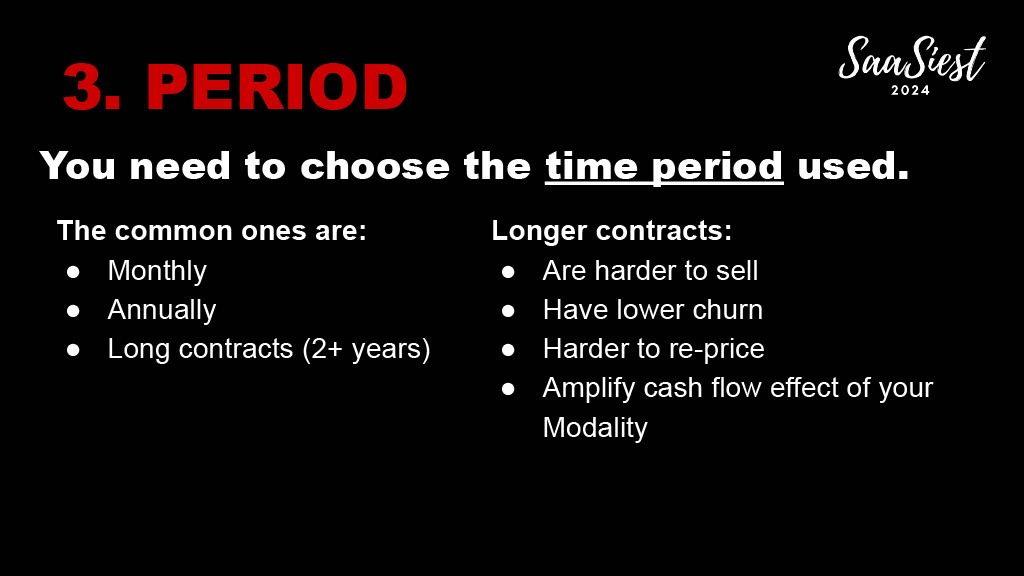Pricing your product is one of the most critical and challenging decisions you’ll make as a B2B SaaS leader. It’s a question that comes up time and again, and while it might seem straightforward, it’s often ill-formed. That’s where Ulrik Lehrskov-Schmidt, a seasoned B2B SaaS pricing consultant, steps in. At SaaSiest 2024 earlier this year, Ulrik shared his insights through 3 critical frameworks that will help you approach pricing in a new way.
It’s about maximizing revenue
When asked, “How do you price your product?” Ulrik suggests we’re asking the wrong question. Instead of focusing on the product, the real focus should be on maximizing revenue in the market. By shifting the conversation, you’re able to gain new perspectives and strategies that drive greater profitability.
“We’re not trying to price the product. We’re trying to price the customer.”
–Ulrik Leskov-Smith, B2B SaaS pricing consultant
The 6 components of pricing architecture
Pricing isn’t just about picking a number; it’s about constructing a solid pricing architecture. Ulrik breaks this down into six key components:
- Pricing metric: What exactly are you measuring, and how does your customer perceive value? This is foundational to ensuring your pricing aligns with how customers experience and benefit from your product.

- Modality: How are you charging? Is it per user, per feature, or based on another model? Your chosen modality should reflect the way customers use and derive value from your product.

- Period: Are you billing monthly, annually, or on a different schedule? Common billing periods include monthly and annual contracts. Longer contracts, while harder to sell, typically result in lower churn but can be more challenging to re-price.

- Granularity: How detailed are your pricing tiers or packages? This could range from the smallest possible “unit” per use—ideal for granular pricing—to larger units for “chunkier” pricing, or even a series of “tranches” designed to accommodate different customer sizes.

- Discounts: When and where should you offer discounts, and what impact will they have? Two major discounting strategies include:
- Threshold discounts: For example, after 100 users, offer a 10% discount on all users, including the first 100.
- Waterfall discounts: After 1,000 users, offer a 10% discount on all subsequent users.

- Price points: Consider two critical questions: What should my smallest customer pay? Who are they, and what’s a reasonable price for them? And, what should my largest customer pay? This helps you determine the discount slope and what volume should trigger a price adjustment.

Solve for risk and de-risking the pricing process through a step-by-step approach
“You have to take risk seriously. If a price increase feels risky – it probably is. So figure out why it feels risky and then work backwards from there. Structure a process that allows you to remove that risk piece by piece. Test. Validate. Roll out in phases. Ultimately this allows you to be more aggressive and take more risk. I call it ‘Solve for risk’”
–Ulrik Leskov-Smith, B2B SaaS pricing consultant
Imagine raising prices by 600% for your five largest customers. Now, what if you’d already done it for your next 25 largest, and even before that, for all your other customers? Achieving this level of price increase isn’t just about setting a higher price tag; it’s about building momentum through a step-by-step process.
This process involves securing customer approval through interviews, gaining internal support across all departments, and ensuring full buy-in from key management stakeholders. Starting with a core group, testing and refining the model, and gradually expanding until the entire market is on board. This methodical approach helps de-risk the pricing process and achieve significant, sustainable growth.

Here are 4 key-takeaways:
- Rephrase the pricing question to focus on maximizing revenue in the market.
- Consider the six components of pricing architecture: pricing metrics, modality, period, granularity, discounts, and price points.
- Solve for risk and de-risk the pricing process through a step-by-step approach.
Whether you’re struggling with pricing decisions or looking to refine your strategy, Ulrik Leskov-Smith’s keynote at SaaSiest 2024 has the answer you need to renew your approach to hiring and boost your ARR.




